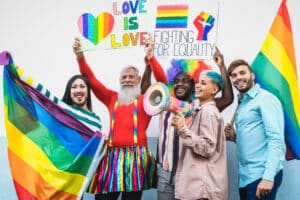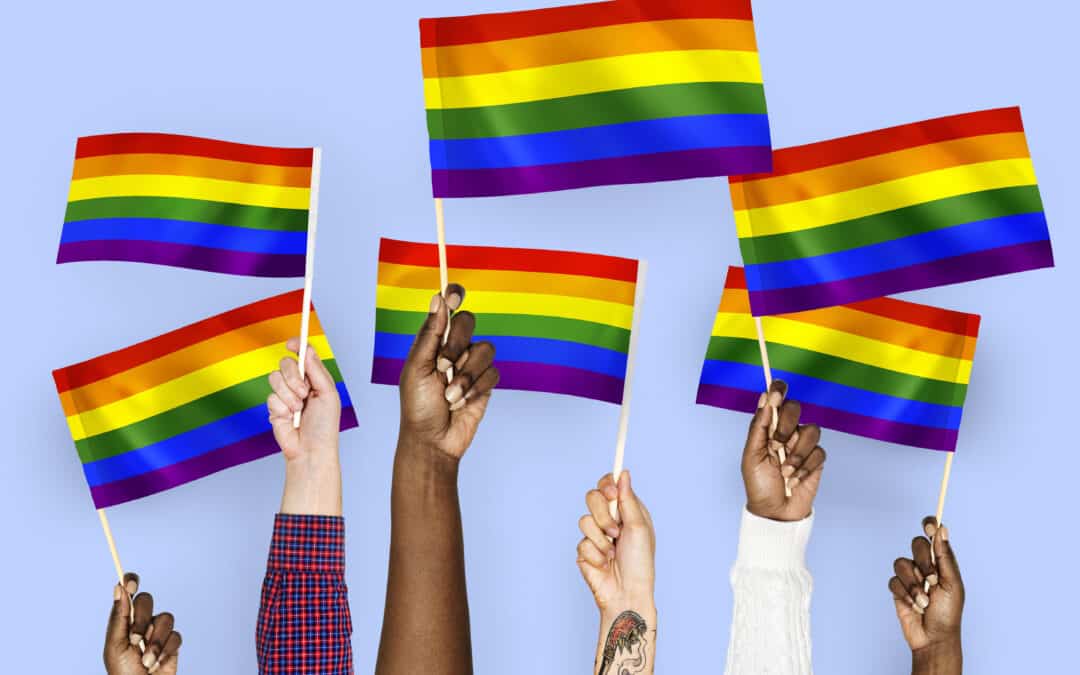We see it every year. As June comes to a close, many companies pull down their rainbow banners and delete their rainbow profile pictures on social media. Corporate messages of “love being love” are replaced by the social media posts we are used to seeing throughout the year. As LGBTQ+ rights become more universally accepted across the country, we see this pattern play out in many companies. While June can be a good month to show your support of the queer community, making this sudden shift away from LGBTQ-friendly social media posts after June is not a healthy marketing strategy for businesses.
In this article, we will cover why you should reach out to the LGBTQ community and how your content marketing strategy can become more queer-friendly.
Why Representation Matters For Your Content Marketing

The LGBTQ community is only expected to grow as members of younger generations grow up in a more accepting world.
Before we delve into how to go about crafting more inclusive social media marketing content, it’s important to address why businesses should make this transition. Most of the time, the first reason to come up is that it is the right thing to do. People deserve to feel accepted and safe, and showing people who look like them and have the sorts of relationships they do furthers human rights issues.
From a pragmatic standpoint, inclusive marketing is good for business. Studies have shown that across the U.S., 7.1 percent of the population identifies as part of the LGBTQ community. As more people grow up in a country that is more accepting, that number is projected to grow. Here are the demographics of LGBTQ+ identifiers from the same Gallup study:
- Generation Z (born 1997-2003) – 20.8 percent
- Millennials (born 1981-1996) – 10.5 percent
- Generation X (born 1965-1980) – 4.2 percent
- Baby Boomers (born 1946-1964) – 2.6 percent
- Traditionalists (born before 1946) – 0.8 percent
What this indicates is upcoming generations who will have increased purchasing power will be looking for companies and businesses that represent them. If they have to choose between a business that shows support in their content marketing and one that does not, who do you think they would choose?
LGBTQ Inclusive Marketing Reaches Out To Allies
People within the queer community are not the only ones who care about representation. As a business, you also need to consider the voices of allies. Allies are cisgender (people who identify with the gender they were assigned at birth), straight people who care about and support LGBTQ people. A separate Gallup study indicated that 71 percent of the U.S. population believes that LGBTQ rights are “morally acceptable.”
When you angle your marketing strategy to include members of this community, you are also reaching out to the 71 percent of the population that supports LGBTQ rights. You don’t have to be a marketing specialist to see the potential there.
Incorporate Word-Of-Mouth Marketing Into Your Marketing Strategy
Additionally, one of the best ways to grow your business is by increasing brand loyalty. Despite all the advances in marketing and advertisements, the best form of marketing is still word-of-mouth, and people within disenfranchised communities talk. Even in places where they experience less discrimination, LGBTQ people tend to form close-knit communities. If they know your business is somewhere where they and their loved ones will be accepted, they will make sure to let others in the community know.
While content marketing creation shares many of the same skills for crafting an effective story, new members of your audience should be able to join at any point and be able to grasp what your business is about. By using some of the methods we will discuss later in the article, your business can quickly indicate your values and some other qualities. Some values your audience will be able to assume your business holds are thoughtfulness, open-mindedness and compassion.
LGTBQ-Friendly Marketing Makes Financial Sense
With the purchasing power of new generations to consider, it should come as no surprise that businesses that are supportive of the queer community are already performing better financially. One study by the Human Rights Campaign stated the following:
Taken as a whole, our empirical findings provide strong evidence to suggest that LGBT-friendly corporate policies enhance firm performance. These findings can be considered to support the view that socially progressive corporate policies and diversity management pay off and create value for the firm.
The same study also indicated that 23 percent of LGBTQ people have switched products because another company was more supportive – even if that brand cost more or was less convenient.
Some might worry that taking a stance on human rights might alienate members of the community who are opposed to these human rights, but the research shows where the future is headed.
LGBTQ Support Means More Than Pride Month
As more of the U.S. population continues to show support for members of the queer community, it is natural for businesses to start stepping in to show their support. During Pride Month, the internet is flooded with rainbows. Companies pay thousands to put together floats for Pride parades. But as we mentioned earlier, many businesses limit their support and representation of LGBTQ people to one month out of the year.
This does not mean that members of the queer community are ungrateful for the support. The support of corporations signals a level of acceptance that was not present in our culture as little as 10 years ago. That said, the sudden shift to posting queer-friendly content in June can feel opportunistic. Rather than a celebration of how far LGBTQ rights have come (and still have to go), it can feel like a grab for attention.
While many members of the queer community are happy to see representation at all, seeing it throughout the year will go a long way toward building brand loyalty and trust. After all, people don’t stop identifying how they identify just because Pride Month is over.
Research also suggests that businesses would benefit from incorporating their progressive messaging into their business practices.
Pete Holmes, the director at Stonewall, offered suggestions for ways businesses can be more LGBTQ-friendly:
Being an LGBT-inclusive employer is a process that can start with everyday actions. This can range from activity like pledging support during Pride or Trans Day of Remembrance, hosting LGBT networking events, profiling LGBT role models in the workplace or offering diversity training to staff. Each of these kinds of initiatives can help create a work environment where LGBT staff can be themselves and, because of that, thrive at work.
If you do choose to participate in these ways, make sure to feature this work in your marketing content.
Using Inclusive Language In Your Content Marketing
Language is a powerful tool for social change, which is why it is so important that your marketing content communicates the messages that you want to send. Our Three Girls Copy Editor, Heather Cooper, put it best in her article about using inclusive language in marketing.
Using inclusive language is essentially being conscious of the language you choose so as not to exclude anyone from the conversation. Being purposeful about using inclusive language in your content marketing not only shows your audience that you’re aware of issues that affect them in their day to day lives, but that you’re also willing to grow and change as your awareness increases.
Most of the time when we edit and revise content for a wider audience, we look at facets of grammar, style and voice, but inclusive language is just as – if not more – important.
As Heather mentioned, using inclusive language effectively brings more people into the conversation. The more people who can access your marketing content, the more people who will learn about your product or service.
Here are some ways you can make your copy more inclusive as you create your content.
Use Gender-Neutral Language In Your Content Marketing
Whether you fall on the conventional gender spectrum or not, the use of she/he has always been clunky for referring to hypothetical people. Referring to hypothetical people with pronouns that don’t align with your audience can be exclusionary. In recent years, many have opted to use they/them to refer to a person with indeterminate gender.

Remember that gender expression is not the same as gender identity. Use gender-neutral terms in your content marketing when you are unable to ask someone’s pronouns.
They/them is also used by non-binary people as well. As an article from Forbes put it, “For those who don’t fall neatly into the male or female categories, these constant references to the binary male and female groupings can be alienating. Even for those who do identify as male or female, these constant reminders of gender may have an impact. Constantly dividing everyone into male and female categories may make us perceive men and women as more different than we really are.”
Using they/them to refer to individuals in your content marketing signals that your business wants to open the conversation to everyone.
Using gender-neutral language also extends to other facets of your diction. Some alternative words to use for gender-neutral language include:
- Partner instead of girlfriend, wife, boyfriend or husband
- Sibling instead of brother or sister
- Firefighter instead of fireman or firewoman
- Humanity instead of mankind
LGBTQ Terms and Terminology
For those who are not already a part of the queer community, the terms LGBTQ people use to communicate their identities can be overwhelming. Here are a few key ideas to keep in mind as you craft your marketing content.
- Gender Is Not The Same As Sex. Gender refers to who a person identifies as, whereas sex refers to their biology. The gender someone is assigned at birth does not always correspond with who they are. Whether you are referring to members of your audience or providing captions for photos, leave your assumptions behind. You can always use gender-neutral language if you are uncertain, or better yet, you can always ask what pronouns a person uses.
- Sexual Identity And Gender Identity Are Not A Preference. Five to 10 years ago, it was common practice to ask people what their “preferred pronouns” were. While this question was often asked with the best intentions in mind, the assumption that identity was a preference was problematic. People don’t choose who they find attractive or how they identify. Most members of the LGBTQ community will understand that your business intends to be supportive, but it is better to get ahead of any potential backlash.
- Gender Expression Is Not The Same As Gender Identity. It is also important to note that gender expression can also differ from gender identity. Gender expression is defined by the HRC as, “External appearance of one’s gender identity, usually expressed through behavior, clothing, haircut or voice, and which may or may not conform to socially defined behaviors and characteristics typically associated with being either masculine or feminine.” For example, a woman might wear traditionally masculine clothes but identify as a woman. Alternatively, someone might present in an androgynous way and use he/him pronouns.
LGBTQ Language Evolves With Culture
In the same way that “preference” was more acceptable to use several years ago, language evolves and changes over time. As a content marketer, it is important to keep an open mind and continue to learn.
Our Copy Editor, Heather Cooper, said it best in her article about the importance of being a lifetime learner. “In order to stay relevant in your field, drive progress and maintain your clients, you must stay on top of the trends and research — not only that, you must strive to stay ahead of them.”
As LGBTQ culture continues to develop and language changes with it, it is important to be gracious and understanding about new changes. It is okay to make mistakes. What matters is that you learn from them and move forward with the times. If you do so, your marketing content is sure to benefit.
LGBTQ Representation In Media
When it comes to content marketing, a picture really is worth a thousand words. If you want to reach out to the queer community, one of the easiest ways to do that is through your media. Not only do videos and images draw more attention than text-only posts on most platforms, but they also offer a unique opportunity for easy, clear communication of your business’s mission.
As with any content marketing to reach a specific audience, there is a right way and a wrong way to do it. Quirk’s Media offered several helpful suggestions for how to engage LGBTQ consumers. We’ve included a few of them below:
- Ads in which LGBT content doesn’t overwhelm the brand story are highly effective. Even as more people become accepting of LGBTQ people, there is still a dearth of representation of queer people in advertisements. Generally speaking, they are happy to have any positive representation, but when marketing content does not connect the brand to the representation, it can come off as pandering to the audience. When you create content that features members of the queer community, ensure that you don’t lose sight of your brand message in the process.
- Depicting “real, everyday” LGBT consumers in realistic settings is highly appealing. LGBTQ people are people. They have relationships, go out for coffee and go to work. Sexuality and gender identity are facets of who people are. While their identities interact with a lot of our day-to-day interactions, it is by no means everything. Reflect that with your marketing content.
- Ads depicting genuine emotional connections between LGBT people are greatly appreciated and potentially create strong affinity between the advertiser and LGBT consumers. As we mentioned before, many of the depictions of members of the queer community are not good ones. While many businesses are moving away from this, we still see stereotypical images and depictions of LGBTQ people. If you’re looking for positive examples of queer representation in marketing content, Quirk’s Media suggests looking at recent advertisements from Marriott, AT&T and Subaru. Show members of the community and allies that you care about representation and how people are represented in your marketing content.
Intersectionality In LGBTQ Marketing
While members of the queer community are often unified in a desire for acceptance and respect, it is important to note that this community is not homogeneous. As with any community, people come from different cultures, have different races and ethnicities and practice different religions.
For that reason, it is critical to include images and content marketing strategies that represent these differences. Three Girls President-CEO Erika Taylor Montgomery discussed this topic in greater depth in her article about multicultural marketing.
Are you ready to start crafting your LGBTQ-friendly content marketing? Let us help! We have marketing and PR specialists that can help you make the most of your marketing strategy. Contact us for a free consultation today!
Special Offer:
Sign up for a complimentary consultation during December and receive an Annual Marketing Planning Guide valued at $475! We offer a 30-minute phone consultation with our CEO, and can answer your questions and discuss your specific marketing needs - no strings attached. Call 408-218-2391 or contact us today to arrange your consultation!


